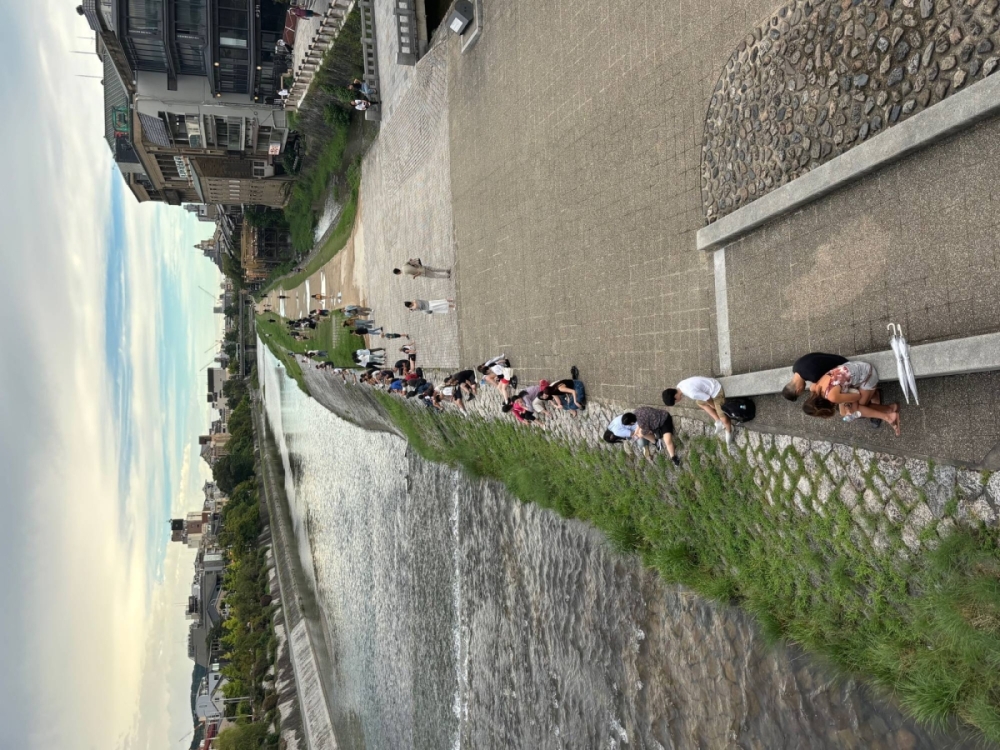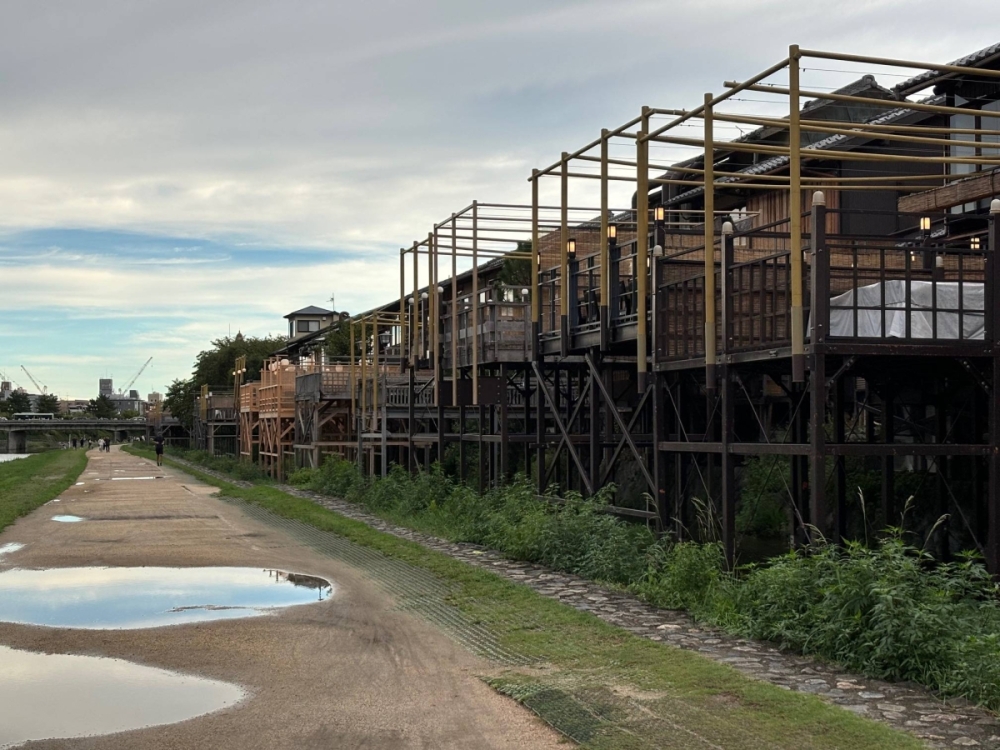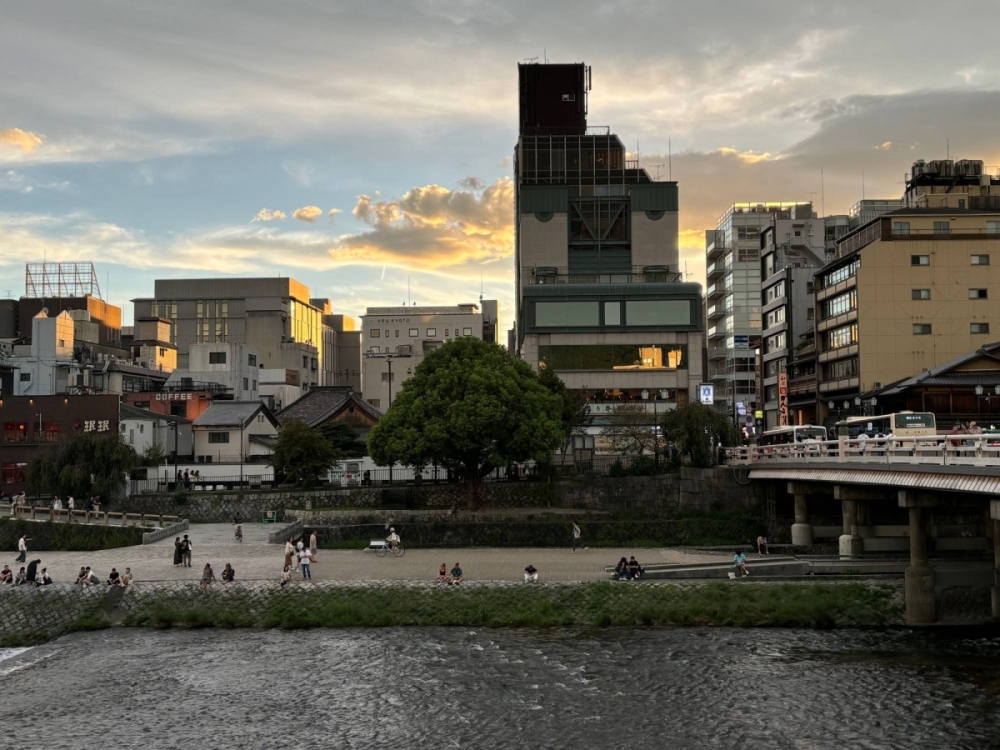Among Kyoto’s myriad temples, shrines and other tourist hot spots, the Kamo River stands out as a rare refuge from the crowds choking the rest of the ancient capital.
If the weather is nice, and even sometimes when it's not, you are guaranteed to see people out enjoying the modest green spaces sandwiching this gentle waterway that cuts through Kyoto’s eastern neighborhoods. On weekends, it's not unusual to see people out for a jog or walking their dogs along the banks, while others play badminton, picnic with friends or even cuddle up with a loved one. You may see a man play his harmonica to a group of waterborne ducks or an eccentric Kyotoite out walking their mongoose (rare, but it happens).
At night, especially on the weekends, groups of people gather around street musicians, magicians or even acrobatic performances. There has never been a Saturday in my nine years of living in Kyoto where there wasn’t music, drinking and some form of spontaneous community forming near the waters of the Kamo River.
Given the river’s centrality and visibility — slicing from north to south through Kyoto’s eastward districts — its mere presence serves as a natural social magnet.
One day in late August, I was able to speak with several groups of people out and about enjoying a sunny afternoon by the river.
“We found it by accident,” says Showana, an Argentine tourist who was walking on the grass by the river when I came across her. This is her first time in Japan.
“Yeah, we had no idea it was here — we just stumbled on it,” adds Lucia, who joined her on the trip.
Overseas tourists seeking advice online on what to do in Kyoto can often find themselves surprised by the Kamo when they arrive. The river and its environs lack the urban polish that comes from months of meetings in a city planning department. While there are some seating areas, the riverbed appears largely untouched.
“Japan is so clean, so I was surprised to see grass and weeds growing all over the banks and the old buildings,” says Juan, a tourist also from Argentina who is sitting with friends, listening to someone play the guitar by the water. He expresses amusement that the riverbank is not kept in better order given its popularity.
Therein lies the draw of the Kamo, a splash of ruggedness in Kyoto’s ancient cityscape.
“I come once a month during the summer,” says Lauren, a U.K. native and Kyoto resident of seven years. She is sitting by the river enjoying a drink with her friends. “But during the rest of the year, I’ll go two or three times a month. It’s the perfect place to go either when you have no specific plans or the restaurants and bars are too crowded and you can’t make a reservation.”
Wild Duck River
With a name that literally translates to “Wild Duck River,” the Kamo descends from Mount Sajikigatake just north of Kyoto and extends over 31 kilometers southward, but just 10 km or so cuts through the heart of the city.
In spring, the banks of the river explode into brilliant whites and delicate pinks as the cherry blossoms emerge. In fall, the oranges, reds and gold of autumn foliage take hold. Through most of the year, water levels are low enough to cross the river on stepping stones that span its narrow points. During the rainy season, though, the riverbed fills up, rarely flooding over the banks — hence why many kawayuka (riverside restaurants), some dating back as far as the 17th century, have decks built atop wooden posts.
In modern Kyoto, restaurants, shopping arcades, nightclubs and the trappings of what you would expect to find in a city of 1.45 million aren’t far from the calm Kamo. The Pontocho district, an atmospheric alleyway full of exclusive establishments and other dining options, runs along the western side of the river, and the Kawaramachi area, with its own bars and eateries adjacent to a gentle stream, mimics the Kamo’s allure. To the east sits the old Gion district, where geiko and their maiko apprentices still entertain to this day in members-only teahouses near the river.
It’s not just humans who see the Kamo as a refuge — the river is home to a plethora of wildlife, from its namesake ducks to stilt-legged herons that stalk the water for food. High above, kites circle above unsuspecting lunchers, diving low when they sense an opportunity to steal a bite.
One of the more unique and somewhat terrifying animals that frequent the Kamo is the nutria. Originally from South America, these large rodents resemble a cross between a capybara, a rat and a beaver with red-tinted front teeth. They are an invasive species in Japan, but spend any time by the Kamo, especially when there aren’t many people out, and you’ll likely be greeted by one swimming in the gentle current and eating weeds.
The Kamo through the years
As the Kamo remains an integral part of Kyoto’s social fabric today, so, too, has it been throughout the city’s history.
The most famous legend associated with the river comes from the Heian Period (794-1185). As a previously peaceful Kyoto slid with the rest of the country toward civil war and the nascent class of samurai began to seize power from the city’s aristocrats, a warrior monk named Benkei, blessed with superhuman strength, is said to have patrolled Gojo Bridge (it now stands in a different location), dueling samurai and collecting their swords as punishment for their arrogance. Benkei had amassed 999 swords in his collection when, one night, a young samurai (later revealed to be Minamoto no Yoshitsune, one of classic Japanese literature’s great tragic heroes) attempted to cross the bridge. The two dueled, Yoshitsune prevailed and Benkei, moved by the display of martial prowess from the young samurai, pledged his fealty for the rest of his life.
In 1590, Toyotomi Hideyoshi rebuilt the Sanjo and Gojo bridges in their current locations, attracting many to the riverside to sell their wares, give performances or simply socialize. In 1603, the art of kabuki is thought to have been created in a dry riverbed of the Kamo by entertainer Izumo no Okuni and her all-female acting troupe.
As the years passed, the people of Kyoto continued to gather at the river to witness various festivals, the most famous of which was the Gion Matsuri. Here, the Kamo played a special role — having carried mikoshi (portable Shinto shrines) from places of worship across Kyoto, priests would then dip ritual wands into the river’s flow before sprinkling the mikoshi with its pure waters. The crowds became so great for these mikoshi arai (ritual washing of the shrines) that teahouses had to limit the amount of patrons they let sit by the river.
During the Meiji Era (1868-1912), yuka (wooden platforms elevated on bamboo pillars) were set up below the river’s bridges as summertime cool-off spots. The area below the Sanjo Bridge was particularly popular, as it still is today — minus the yuka, of course.
Not that any of that history is top of mind for most people looking for a few quiet moments next to the Kamo’s lazy current — especially mid-20s Japanese couple Ryotaro and Yukina, who moved from Shizuoka to Kyoto earlier this year.
“I feel calm and away from the city here,” Yukina says while relaxing by the river. “I feel like I can have a conversation here.”
“I feel free here,” adds Ryotaro. “It’s a nice walk in nature, but people can do whatever they want. They can smoke, drink or just do nothing all day.”




























With your current subscription plan you can comment on stories. However, before writing your first comment, please create a display name in the Profile section of your subscriber account page.